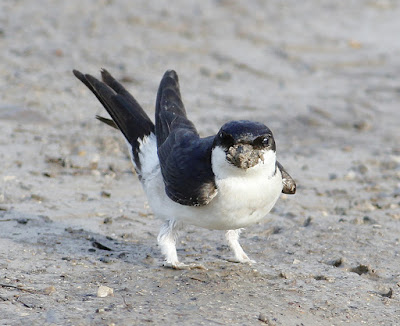With a cool, clammy mist and the temperature gauge showing 6⁰ the morning had a definite autumnal feel but one which promised sunshine. At Braides Farm the Buzzard sat along the fence posts waiting for the off.
Dont forget to "click the pics" for a better birding experience.
Morning Glow - Cockerham
Buzzard
The mist cleared quickly in the strong sunlight and Conder Green was haze-free. There are good numbers of Lapwings feeding and roosting around the pool margins now, some 150 birds, part of the large numbers which commute between here and in the fields on the other side of the canal. A later drive around Jeremy Lane found a further 150+ Lapwings as well as similar numbers of Curlews. Good numbers of Brown Hares in evidence with sometimes just their ears visible in the silage fields.
Lapwing
Brown Hare
Back at the pool I counted 1 Meadow Pipit, 4 Pied Wagtail, 4 Little Grebe, 1 Wigeon, 4 Little Egret and 1 Grey Heron. Otherwise most of the action was in the creeks with 3 Greenshank, 6 Common Sandpiper, 70 Redshank, 4 Curlew and a single Shelduck.
Greenshank
Eight or ten Swifts hawked above the hedgerow again as a handful of Swallows and Sand Martins circuited the pool, but the morning here was mostly House Martins. Feeding around the railway bridge and the dwellings were approximately forty. Perhaps not all were from the small number of nests on the few houses here although some martins were still busy collecting building materials from the roadside. A Sparrowhawk appeared from above the houses but the martins were onto it instantly as the hawk took a few flaps and a long glide and headed off towards the pool.
House Martin
I called at Glasson to enjoy the light and to see 20+ Swallows, 3 Swift, 3 Pied Wagtail and 1 Grey Heron.
Grey Heron
Glasson Dock
Next I checked a couple of ringing sites for possible visits. First the quarry and 90+ Sand Martin, 20 Linnet, 15+ Tree Sparrow, 4 Pied Wagtail, 1 Curlew, 1 Oystercatcher and 1 Golden Plover.
Then came Oakenclough, the ringing site destined for a visit pretty soon. Although it’s only early August Andy and I have put up a few feeders to see just when birds begin to use them. At the moment there is lots of natural food but there seemed to be a small number of Chaffinches, a couple of Siskin, and a single Lesser Redpoll in the area of the feeders.
In the wider plantation to where we erect mist nets - 5 Willow Warblers, 2 Pied Wagtail and 1 Great-spotted Woodpecker.
On the water- 2 Tufted Duck, 1 Great Crested Grebe and 120+ Greylags.
Tufted Duck
The weather looks marginally better for the weekend so there should be more birds on Another Bird Blog. Log in soon for more birding around.
Linking today to Theresa's Ranch , Anni's Blog and Eileen's Saturday.
Linking today to Theresa's Ranch , Anni's Blog and Eileen's Saturday.



















































































